
NPS Songbirds and woodpeckers, or passerine and near passerine species, comprise the majority of bird species in Yellowstone National Park. They are monitored through counts in willow stands, recently burned forests, old growth forests, and grasslands/ sagebrush steppe; the North American Breeding Bird Survey; fall migration surveys; and a summer and early fall banding station. WillowsWillow stands are one of a few deciduous wetland habitats in the Greater Yellowstone Ecosystem. Bird diversity is considerably higher in wetland habitats than in grasslands, shrublands, and upland coniferous forests. Several Yellowstone bird species, including Wilson’s warbler (Cardellina pusilla), willow flycatcher (Empidonax traillii), and gray catbird (Dumetella carolinensis), only breed in willow communities. From the early 1900s, growth of willows and other woody vegetation on Yellowstone’s northern range was stunted (suppressed) by elk browsing, reduced beaver populations, consumption by fire, and/or climate change. Correlated with the recovery of several large predator species in the park, some willow stands in the northern range have grown taller and thicker since the mid-1990s, creating a range of growth conditions in current willow stands. Monitoring of willow–songbird communities in Yellowstone began in 2005. Scientists compare the presence and abundance of breeding songbirds across different willow stand conditions. In 2021, park staff recorded 39 songbird species in willows. Species richness (diversity) was higher in taller than in suppressed willows. Recovered willow stands provide shrubby cover for ground and low nesting species such as song sparrows. Suppressed willows appear to provide habitat for generalist and grassland/sagebrush species. Willow stands are slowly changing and biologists plan to regularly reassess the vegetation characteristics as bird communities continue to be monitored. Mature ForestsWhile the importance of mature and old growth forests to songbirds is poorly understood, mature forests notably provide nesting habitat and foraging opportunities for many species that young stands do not. Climate warming may cause more frequent and severe fires in Yellowstone National Park, which could disproportionately impact mature forest stands that, by definition, take longer to regenerate post-burn. Due to the potential loss of this habitat type as the climate changes, park biologists initiated songbird surveys in three mature forest types in 2017 to document the bird communities that currently use them. No surveyed forests had a major disturbance (i.e., wildfire) in at least 100 years, although forest structure and tree species composition varied. In 2021, observers recorded 21 species and the most abundant species were pine siskin (Spinus pinus), mountain chickadee (Poecile gambeli), American robin (Turdus migratorius), ruby-crowned kinglet (Regulus calendula), yellow-rumped warbler (Setophaga coronata), and dark-eyed junco (Junco hyemalis).Species richness increased with forest complexity from 11 species in lodgepole dominated and mixed lodgepole-spruce forests to 18 species in Douglas fir and spruce. Burned LandscapesBirds are among the first returning vertebrates to a forests affected by fire. Birds that nest in cavities of trees depend on forest fires to provide their habitat—and different species depend on different effects of forest fires. For example, black-backed (Picoides arcticus), American three-toed (P. dorsalis), and hairy (P. villosus) woodpeckers use trees that burned in low to moderately severe fires, two to four years after the fire. Northern flickers (Colaptes auratus) move into severely burned areas three years after a fire. Standing dead trees left behind after a fire attract bark and wood-boring beetles—primary prey for woodpeckers. Nest cavities created by woodpeckers are later used by chickadees, nuthatches, bluebirds and some species of duck. Because fire size, frequency, and intensity is expected to increase with climate change, scientists are studying how the different bird species use different types of post-burn forests and they are developing monitoring methods for the future. Grasslands/Sagebrush SteppeGrasslands are a threatened habitat type across the continent and grassland songbirds are the most imperiled songbird guild in North America. In Yellowstone, grasslands and sagebrush steppe are impacted by invasive plants, changing intensities of ungulate browse, and climate change. In 2021, bird program staff and volunteers conducted songbird surveys in sagebrush steppe and grasslands across the northern range, in areas that vary in bison grazing intensity as well as native and invasive plant species composition. Staff observed 13 species of songbird in grasslands and sagebrush steppe in 2021. In areas with high grazing intensity and abundant non-natives, the most abundant species were horned lark (Eremophila alpestris), vesper sparrow (Pooecetes gramineus), and western meadowlark (Sturnella neglecta). At other sites, species diversity varied significantly, although Brewer’s sparrow (Spizella breweri), vesper sparrow (Pooecetes gramineus), and savannah sparrow (Passerculus sandwichensis) were all common. Breeding Bird SurveysNorth American Breeding Bird Surveys (BBS) are a continent-wide monitoring effort coordinated by the US Geological Survey, the Canadian Wildlife Service’s Research Center, and Mexico’s National Commission for the Knowledge and Use of Biodiversity (CONABIO). Since the 1980s, Yellowstone National Park has participated in these long-term surveys conducted throughout North America. The surveys are road-based with the registered observer recording all birds seen and heard within a quarter mile radius; survey points occur every half mile. Surveys are conducted in June, during the height of the songbird breeding season, and occur on three routes: Mammoth (Indian Creek to Tower Junction), Northeast Entrance (Tower Junction to Round Prairie), and the Yellowstone route (Dunraven Pass to Mary Bay). In 2021, surveyors detected 3,556 individuals of 84 species. The greatest overall bird abundance was observed along the Yellowstone route through the interior. Large flocks of Canada geese along the Yellowstone River accounted for 51% of all observations along the interior route. Canada goose numbers were relatively stable from 1987 to 2010, after which they increased substantially. Fall MigrationFall migration represents an important and vulnerable part of the annual cycle for many songbirds. As they make the long journey south to winter range, migrating songbirds must find appropriate places to rest and refuel. During this season, the songbird community within Yellowstone National Park changes, accommodating species and individuals who do not breed here, but are just passing through. In addition to breeding season efforts, Bird Program staff monitor autumn songbirds in willow stands, old growth forest, and grassland/sagebrush steppe to better document patterns in habitat use by fall resident and migrating passerines. Songbirds, particularly migrants, were most abundant and diverse in willows in the fall, consistent with patterns seen during the breeding season. In sagebrush steppe, migrants were more frequent and more diverse than resident songbirds, while old growth largely provided fall habitat for resident species. Yellow-rumped warbler, mountain chickadee, and American pipit were the most common fall songbird species in willows, mature forest, and sagebrush steppe, respectively. These surveys highlight the year-round importance of Yellowstone to the resident and migrant avian community. 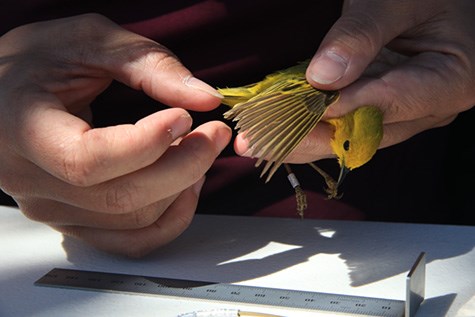
Banding StationWhile songbird counts can provide good estimates for songbird diversity and abundance, they do not provide any information about measures of demography, i.e. reproduction and survival. To improve our understanding of songbird demography in the park, the bird program operated a mist-netting and songbird banding station in 2018, located in a willow-lined riparian corridor on the northern range. During the breeding season, researchers participated in the international MAPS (Monitoring Avian Productivity and Survivorship) program, operated by the Institute for Bird Populations. To help assess use of riparian habitats by juvenile and migrating songbirds, we continued banding operations into the fall, through late September. In 2022, we captured 155 new birds belonging to 30 different species, during the breeding season. Twenty-nine individuals banded between 2018 and 2022 were recaptured at least one time across all banding sessions in 2022. The most commonly captured species in the breeding season were yellow warbler (Setophaga petechia) and warbling vireo (Vireo gilvus). Continued netting and banding efforts in future years will provide additional demographic information that will help researchers better understand songbird population dynamics within the park. ResourcesBaril, L.M., A.J. Hansen, R. Renkin, and R. Lawrence. 2011. Songbird response to increased willow (Salix spp.) growth in Yellowstone’s northern range. Ecological Applications 21:2283– 2296. Saab, V., W. Block, R. Russell, J. Lehmkuhl, L. Bate, and R. White. 2007. Birds and burns of the interior West: descriptions, habitats, and management in western forests. Gen. Tech. Rep. PNW-GTR-712. Portland, OR: US Department of Agriculture, Forest Service, Pacific Northwest Research Station. 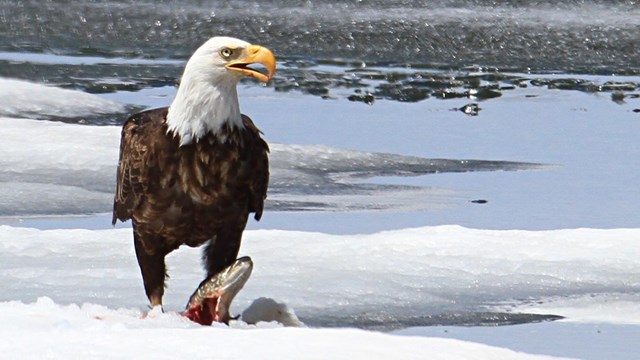
Bald Eagle
Bald eagles can be seen along Yellowstone's many rivers and lakes. 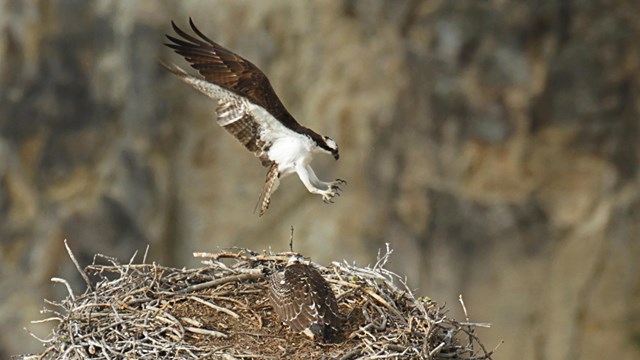
Osprey
Osprey summer in Yellowstone, fishing and raising young. 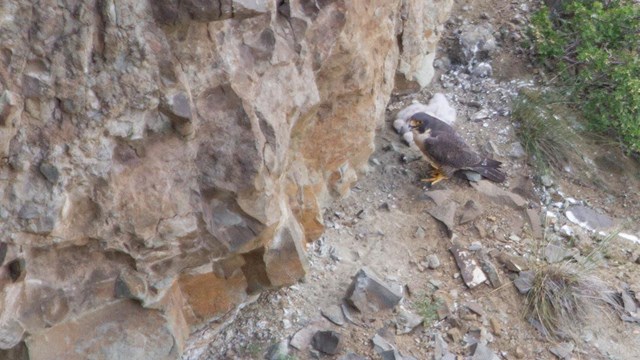
Peregrine Falcon
Peregrine falcons are some of the fastest birds. 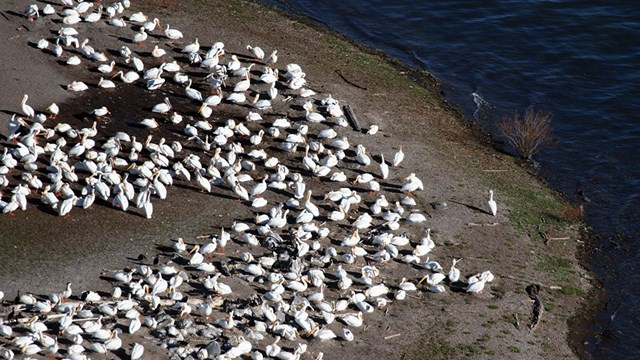
Colony Nesting Birds
American white pelicans and other colonial nesting birds nest primarily on the Molly Islands in the southeast arm of Yellowstone Lake. 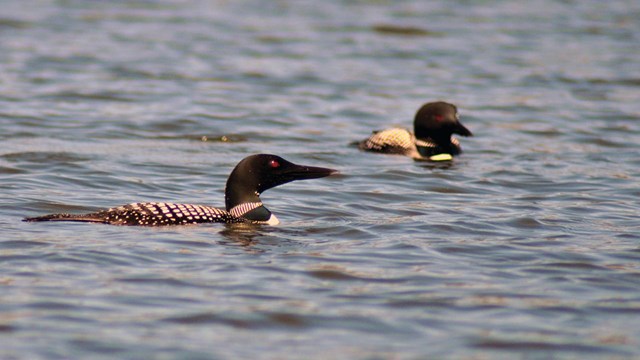
Common Loon
Loons in Yellowstone are some of the southern most breeding populations. 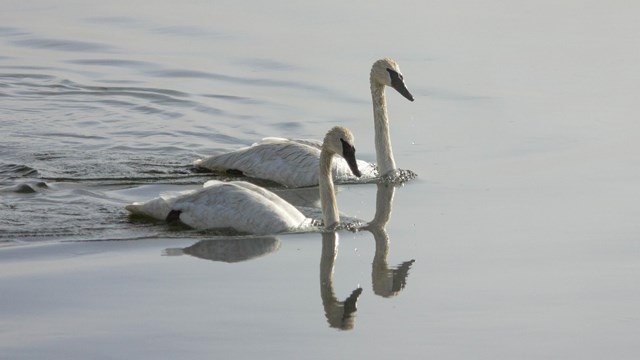
Trumpeter Swan
Trumpeter swans are the largest wild waterfowl in North America. 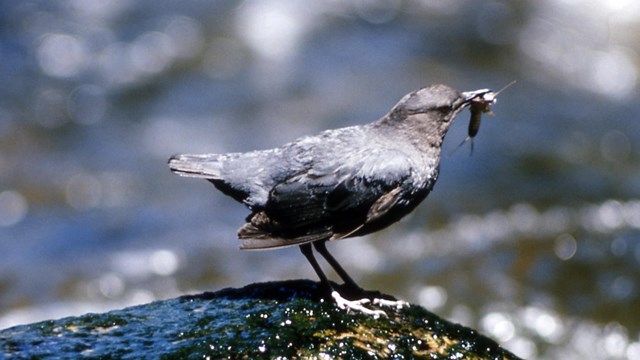
American Dipper
Also known as the water ouzel, these birds dive into water for aquatic insects. 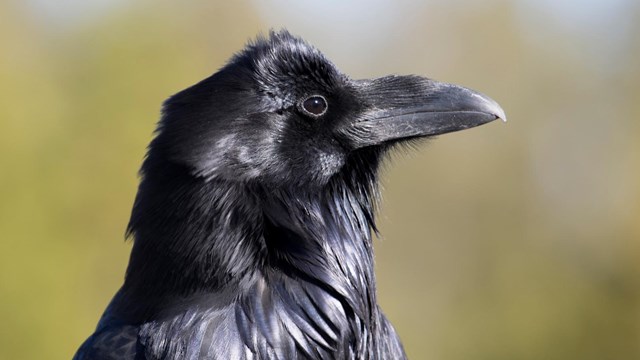
Raven
Ravens are smart birds, able to put together cause and effect. 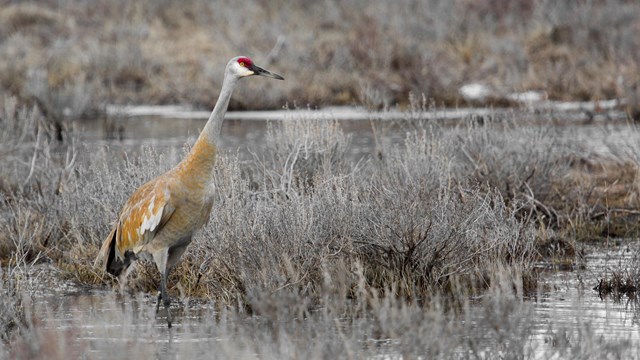
Sandhill Crane
Sandhill cranes nest in Yellowstone during the summer. 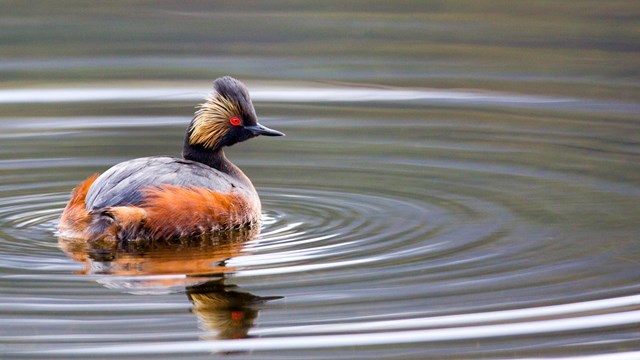
Sound Library
Immerse yourself in the aural splendor of Yellowstone. 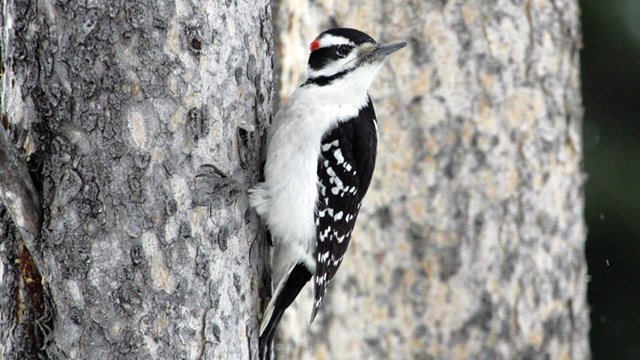
Birds
Spring is a wonderful time to look for birds, as migration brings many birds back to the park. |
Last updated: April 18, 2025
